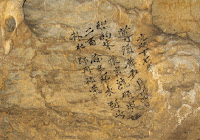Scientists who have discovered ancient graffiti on the walls of a cave in central China and examined the chemical make-up of the cave’s stalagmites say a serious drought is likely to affect the region within the next few decades.
The international research team found a series of inscriptions on the walls of Dayu cave, in the Qinling mountains of central China, that describe the impacts of seven droughts between 1520 and 1920.
The team, which included Chinese scientists and colleagues from the University of Cambridge, UK, has published its findings in the journal Scientific Reports.
The authors say the information in the inscriptions and the team’s detailed chemical analysis of the stalagmites together show how societies are affected by droughts over time. They say this is the first time it has been possible to conduct an on-site comparison of historical and geological records from the same cave.
Reduced rainfall
Their results cover nearly five centuries, but it is one of their conclusions that speaks most directly to the present day: they say their findings point to potentially greatly reduced rainfall in the region in the near future, underlying the importance of preparing for a world where droughts are more common.
The climate in the area around the cave is dominated by the summer monsoon, in which about 70% of the year’s rain falls during a few months. So when the monsoon is late or early, too short or too long, it has a major impact on the region’s ecosystem.
Significantly, the team also found that the droughts they identified corresponded with the El Niño-Southern Oscillation (ENSO) cycle - the periodic weather disturbance centred on the eastern Pacific that can cause widespread disruption.
Because human-caused climate change will make ENSO events more severe, they say, this too could mean that the region faces more serious droughts.
The story of the last five centuries that the cave revealed is dramatic. “In addition to the obvious impact of droughts, they have also been linked to the downfall of cultures,” says one of the paper’s co-authors, Dr Sebastian Breitenbach, a research associate in the University of Cambridge’s Department of Earth Sciences. “When people don’t have enough water, hardship is inevitable and conflict arises.
“In the past decade, records found in caves and lakes have shown a possible link between climate change and the demise during the last 1800 years of several Chinese dynasties, such as the Tang, Yuan and Ming Dynasties.”
Read more at Ancient Chinese Graffiti Warns of Droughts Ahead

No comments:
Post a Comment